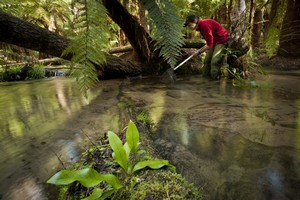Choosing the right tree for the job
 Forest growers are becoming increasingly aware of the ecosystem services and non-market values that forests provide.
Forest growers are becoming increasingly aware of the ecosystem services and non-market values that forests provide.
Based on regular engagement with growers and landowners, our scientists realise many are considering planting indigenous and plantation species other than radiata pine in the belief that they are better suited to provide both market and non-market values. These perceptions will influence the choice of tree species planted in future plantations, with the risk they may not deliver the ecosystem services expected.
To gain a better understanding of growers’ opinions and how they may shape future plantation forestry, our scientists surveyed a cross-section of forestry stakeholders to identify which tree attributes, from a list of 15, they believed contributed to five ecosystem services - amenity value, bioenergy production, carbon capture, diversity of native habitat, and erosion control/water quality. Commercially relevant qualities such as growth rate, disease resistance and timber quality were included in the list, as were qualities such as attractiveness to birds, fire tolerance, shade tolerance and nutrient demand.
Participants were then asked to identify which tree species they believed possessed those attributes from a selection of 22 species, chosen for their forestry-based attributes such as growth rate, wood characteristics, water interception and their ability to adapt to climate change. Five indigenous species - kauri, totara, pohutukawa, kanuka and beech – were also included as their natural geological range matched the land available for forestry. The survey was targeted at individuals who make or influence decisions around forest management and species selection, and was promoted through industry and public channels, generating 139 responses.
“We compared the results of the survey with data from current growth, physiological and ecological studies,” says microbial ecologist Dr Simeon Smaill. “The survey showed that many of our participants hold inaccurate assumptions about the suitability of certain species to provide ecosystem services.  “For example, many participants considered that slow growth was a relatively important attribute for the provision of amenity and diversity services. However, without significant management interventions, slow growing species will generally be outcompeted by weeds.
“For example, many participants considered that slow growth was a relatively important attribute for the provision of amenity and diversity services. However, without significant management interventions, slow growing species will generally be outcompeted by weeds.
“What was more interesting was the high ranking - in terms of providing specific ecosystem services - of one species, Sequoia sempervirens, across all five ecosystem services.”
There is some evidence to support S. sempervirens’ (Californian coast redwood) position in the top spot. Its robust health and ability to tolerate diverse conditions makes it well suited for erosion prone hill country. Its suitability for carbon capture and biomass production for bioenergy is also based on such things as good growth rate, wood density and its ability to coppice. However there are no data describing its ability to provide a habitat for New Zealand native plants and insects and enhancing biodiversity.
Although current markets will likely dictate radiata pine continues to be a dominant plantation species, the growing desire to provide ecosystem services will likely drive increased diversification in some regions.
Many landowners are now appreciating the biodiversity and amenity values that native and exotic forest species can provide,” says Simeon. “This survey highlighted that the accuracy of forest growers’ perceptions varies greatly, and is biased towards species that are familiar but not necessarily better understood.
“It also indicates a need for us, as scientists, to engage more with forest stakeholders about ecosystem services and non-market values so that people can get what they want from their forests in the future.”
Protecting our water through forestry
Exploring the link between the forest ecosystem and the services it provides, and its contribution to the economy and to people’s health and wellbeing, is the subject of Scion’s annual Forest Ecosystems Services Forum.
This year’s forum focused on the role forests play in providing freshwater resources and ecosystem services to New Zealand such as water quality, water yield, recreation and biodiversity.
When it comes to freshwater, forests provide a range of ecosystem services such as providing natural filtration and storage systems that help maintain the quality of our water. Some forests provide drinking water to nearby towns, or are a source of clean water for other productive land uses. They also provide protection from natural hazards such as flooding and soil erosion.
According to Dr Peter Clinton, Science Leader for Forest Systems, the freshwater and riparian habitats found in forests are home to some of the most diverse ecosystems in New Zealand.
“People value the aesthetics of these areas - they are used for recreational and educational purposes and are enjoyed and valued by both Kiwis and overseas visitors. Many of these benefits are not recognised or are undervalued under the current economic environment.”
However, there are trade-offs to be considered. Forests can reduce water yield, particularly in drier areas. In the case of planted forests, water quality and freshwater ecosystems can be compromised during harvesting and contribute to localised flooding, although the effects are usually short-term. “Usually these factors are more than compensated for by the positive freshwater ecosystem services that forests provide,” says Peter. “Land productivity is usually measured in economic terms and does not always include the benefits of the ecosystem services it provides. Including these benefits would allow the comparison of different land uses, and optimised catchment land management for economic return as well as for environmental and social performance.”
“Usually these factors are more than compensated for by the positive freshwater ecosystem services that forests provide,” says Peter. “Land productivity is usually measured in economic terms and does not always include the benefits of the ecosystem services it provides. Including these benefits would allow the comparison of different land uses, and optimised catchment land management for economic return as well as for environmental and social performance.”
Scion’s annual forum provides the opportunity for scientists, foresters and other interested parties to share their latest research and help shape the direction of future ecosystem services research. The forestry industry has a target of increasing the value of New Zealand forest exports to $12 billion by 2022, and as Peter says “This increased intensification must be within environmental limits to protect our access to international markets and to ensure our forests continue to deliver ecosystem services such as high water quality”.
For further information: Contact Dr Peter Clinton at Show email
Dr Simeon Smaill at Show email
